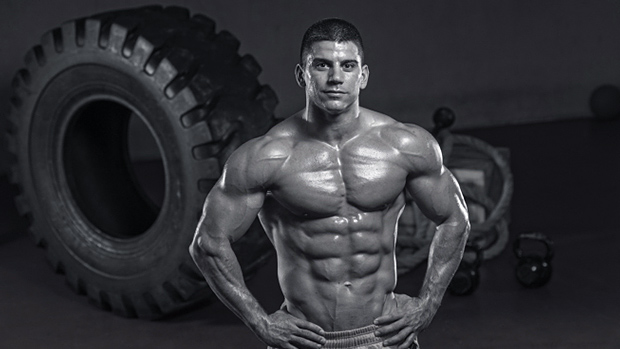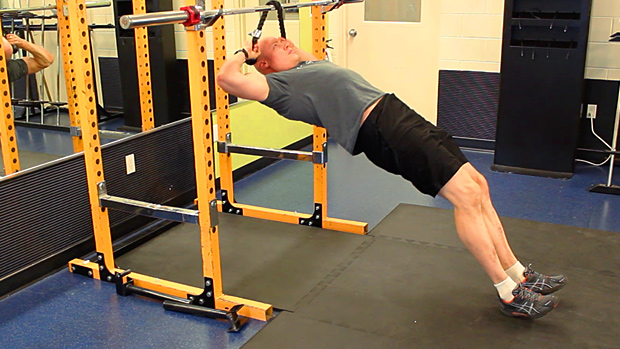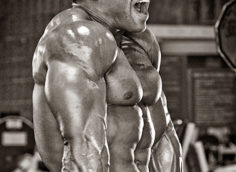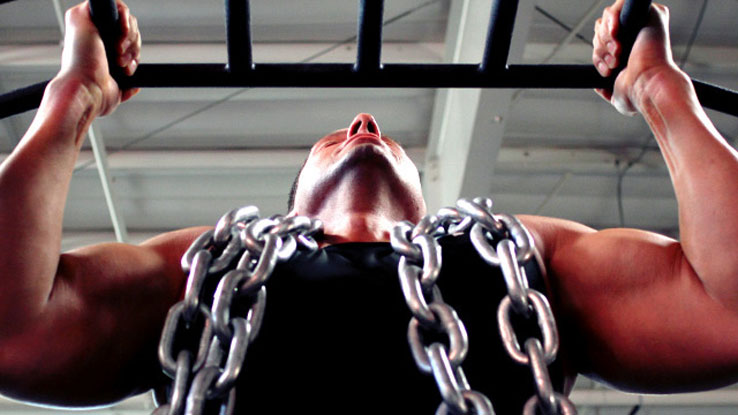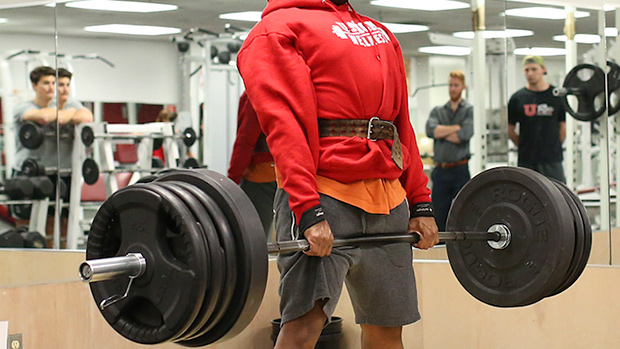Can you lose fat and gain muscle at the same time? Is cardio necessary if you want to get really shredded? Can manipulating the body's natural growth-hormone levels through lactic-acid training be the answer we've all been looking for? Read the following article by Don Alessi and decide for yourself. Better yet, try the program and let us know how it works for you.
It happens every damned time, doesn't it? Like a fat chick in front of a Häagen-Dazs, your progress comes to a screeching halt the last two weeks of your diet. You try not to squander hard-earned muscle mass and strength, but you gotta' make weight. What do you do? Add cardio? Increase exercise volume? E-mail your 'roid dealer?
Mental stress, nutrient restriction and aerobic exercise drive your cortisol levels sky high. If you're not careful, you'll end up a 98-pound poster boy for the Mr. Punyverse competition and be so weak in the gym that even the Body-for-Lifers make fun of your poundages. But it doesn't have to be that way, not if you apply the recent info we have on how your body stores fat and give lactic acid training a shot.
Men have a unique hierarchy of fat mobilization. Basically, men shed fat from the inside out. Studies with male Rangers after prolonged energy deficit and exercise showed regional fat changes from greatest to least as follows:
Abdomen → Trunk → Arms → Legs
That means men lose fat first in the abdomen and the trunk, and lose fat last in the arms and legs. This is what I mean by losing fat from the "inside out." Anyone that's been around the iron game has observed this in novice bodybuilders during contest preparation. The athlete leans out to 10% body fat using a progressively lower caloric intake and then gets stuck. The legs, triceps, and lower abs are still thick. The usual marathon aerobic sessions in combo with a starvation diet sucks the gas right out of the mass. I've witnessed men reduce 18-inch cannons to 15-inch peashooters in order to see a glimpse of leg definition. There must be a better way... and there is!
A better way would be to use a local fat-loss strategy, targeting the extremities (arms and legs) first and the torso last. But is that possible? Yes! Training programs which release growth hormone (GH) are thought to be most effective at doing just that. Before I get into the program, let's examine why this is true.
Remember that fat mass is the enemy, not body mass or scale weight. Body-fat percentage is a factor of fat-free mass (water, muscle, bone, organs and connective tissue) and fat mass. Gaining lean mass while shedding fat mass is the fastest means to altering this percentage in your favor. Let's examine the two obvious training choices: aerobic endurance training (marathon running) and anaerobic resistance training (bodybuilding).
Aerobic endurance training will increase calories burned, increase oxygen utilization, and lower total body mass (scale weight). However, the process isn't substrate specific, meaning your body will just as readily burn lean mass as it would fat mass. Paradoxically, it appears that fat in the trunk is more readily used as the fat source, which means that aerobic exercise doesn't even target the problematic fat!
Over time there's an increased catabolic response and a lowered anabolic response in aerobic endurance training. This is thought to be the reason for muscle-protein breakdown (catabolism) and thus the reduction in muscular strength and power over time. The challenge with aerobic conditioning is that it creates a progressively catabolic environment, combusting both lean mass and fat mass in order to fuel energy demands. (See Table 1 below.)
What about the argument that aerobic training uses more fat as its fuel source than does weight training? This is true, but there's more to the story. Muscle damage induced by running and/or jogging doesn't increase resting metabolic rate (RMR) beyond 24 hours. Data suggests however, that exercise with a significantly stronger eccentric component (i.e. resistance exercise) is necessary to evoke large amounts of muscle damage so that energy required for repair and synthesis may prolong post-exercise RMR.
The energetic cost of this remodeling (anabolism) is enormous, possibly accounting for up to 20% or 600 calories in the average musclehead. Other studies have proposed that there may be even greater energy utilization from the muscle damage that weight training induces. This may account for the increased RMR for up to 72 hours post-workout.
Besides the technical stuff, the practical side of the aerobic thing is that it's boring, time intensive and it wears on your joints, especially if you're a heavyweight. Here's a table to help you see the differences between weight training and aerobic endurance training:
Adaptations over Time of Resistance Vs. Aerobic Endurance Training
| Resistance Training | Aerobic Endurance Training | |
|---|---|---|
| Testosterone | Increases | Decreases |
| Growth Hormone | Increases | Unchanged |
| Cortisol | Decreases | Increases |
| Muscle Strength | Increases | Decreases |
| Muscle Endurance | Increases | Increases |
| Muscle Fiber Size | Increases | Unchanged |
| Bone Density | Increases | Unchanged |
| % Bodyfat | Decreases | Slight Decrease |
| Fat-Free Mass | Increases | Unchanged |
| Volume of Oxygen | Slight Increase | Increases |
Judging by this info, it's pretty obvious which type of training is better for the bodybuilder.
Due to the anabolic effect, weight training preferentially retains or adds lean mass at the expense of fat mass, even during caloric restriction. In fact, the T-Dawg Diet (low-carb/high protein) actually adds to the anabolic effect of weight training.
We know that weight training and supportive nutrition are better than aerobic training for attaining that coveted single digit, body-fat percentage, but what types of training progressions produce the biggest bang? Before I answer, indulge me a bit.
Serum anabolic hormones during prolonged weight training (six months) increase in direct proportion to strength gains. These results suggest the importance of the balance between androgenic-anabolic activity (i.e. Testosterone and growth hormone) and the catabolic hormone cortisol.
The best news is that there's a direct relationship between strength gains and Testosterone production even in elite strength athletes. Maximum Testosterone output is generated with multiple-joint lifts (deadlifts, power cleans, squats) performed at a high percentage of maximum (85 to 95%) and at a high volume (6 to 12 sets). Traditional powerlifting programs are well suited for greater Testosterone release (i.e. 8-12 sets of 2-5 reps, 3-6 minutes recovery).
The natural progression of training implies that greater strength is realized and increased tension time is placed on the muscle fibers. This triggers a second anabolic cascade of events. The muscle fibers increase in a cross-sectional area and the quantity of muscle contractile proteins starts to build (hypertrophy). The increase in muscle fiber hypertrophy is thought to occur by a remodeling of protein within the cell and an increase in the size and number of muscle cells. Exercise scientists have noted that these dramatic muscle changes accompany growth hormone secretion (GH). And maximum GH levels are augmented directly through blood-lactate increases.
In order to elicit GH production, sets of 8 to12 RM – along with short rest intervals of one minute or less – are best. Exercise selection must also include multiple joint compound movements that emphasize the leg muscles with a slow concentric (lifting) component. This anabolic condition is the foundation for many of the effective training programs such as the "10 x 10" method or German Volume Training popularized by Charles Poliquin.
To summarize, weight training produces a perpetual anabolic environment, increases calories burned, and leaves time to pursue leisure activities like re-renting Pumping Iron for the tenth time.
With this new understanding and application of GH/lactic acid training, you can soon experience a dramatically lowered body-fat level. But in some cases this still won't be enough; you'll need to supplement your lactic-acid weight training with lactic-acid interval training. If you're in a ballistic sport such as martial arts or boxing, then sparring each afternoon can be considered your interval workout. If not, a rowing ergometer or a simple jump rope will work.
How do you successfully use all this jargon for massive fat loss and explosive muscle gains? The following is a sample progression that forces GH to flood the muscle cells via the stimulation of blood lactate. By the way, I employed this same progression to cut 60 fat pounds off an aspiring Olympic athlete in just under twenty weeks.
This training has been nicknamed "death circuit" and "projectile speed training" by those who've survived it. This is because blood lactate levels rise to 20 mmol/l. You may want a partner to manually force you through all the prescribed sets – or help you clean up!
(Day 1 and 2 are to be repeated twice per week)
Day 1
| Exercise | Sets | Reps | Tempo | Rest | |
|---|---|---|---|---|---|
| A1 | Chin-ups, supinated (palms facing you) | 3 | 10 | 301 | 0 |
| A2 | Squat | 3 | 10 | 301 | 0 |
| A3 | Push-up | 3 | 10 | 301 | 0 |
| A4 | Deadlift | 3 | 10 | 301 | 2 min. |
| B1 | Hanging Leg Raise | 2 | 10 | 030 | 0 |
| B2 | Decline Reverse Crunch * * | 2 | 10 | 103 | 1 min. |
* Tempo — 301 = 3 sec. up and 1 sec. down. 030 = hold 3 sec. at top. 103 = 1 sec. up and 3 sec. down.
* * Decline Reverse Crunch — Performed on a slant board or a Swiss ball where you raise your legs up towards your face.
Day 2
| Exercise | Sets | Reps | Tempo | Rest | |
|---|---|---|---|---|---|
| A1 | Push Press | 3 | 10 | 3 down 0 up | 0 |
| The push press is a shoulder press that utilizes the entire body. Start by standing, with a shoulder-width grip and the barbell resting on anterior delts. Squat one-fourth of the way down to initiate the momentum. Next, press the bar straight over the head to a soft lockout while exploding up on to the toes. Finish by lowering the weight to your shoulders. | |||||
| A2 | Walking Lunge With Dumbbells | 3 | 10 | 301 | 0 |
| A walking lunge looks like a regular lunge except instead of stepping back to the starting position, you step forward with the back leg. You'll end up walking across the floor 20 to 30 feet. | |||||
| A3 | Dip | 3 | 10 | 301 | 0 |
| A4 | Bent Over Barbell Row | 3 | 10 | 301 | 2 min. |
| B | Twisting Crunch on Swiss Ball or Hanging Leg Raise With Twist | 2 | 10 | 030 | 1 min. |
Same as week one. Increase sets to four in the "A" series and three in the "B" series.
Day one and two are again to be repeated twice per week. As an alternate schedule, the lactic acid interval training can be performed on the morning of your off days before your first meal.
Day 1 – AM (morning workout)
| Exercise | Sets | Reps | Tempo | Rest | |
|---|---|---|---|---|---|
| A1 | Chin-ups, supinated | 4 | 10 | 301 | 0 |
| A2 | Squat | 4 | 10 | 301 | 0 |
| A3 | Push-up | 4 | 10 | 301 | 0 |
| A4 | Deadlift | 4 | 10 | 301 | 90 sec. |
| B1 | Hanging Leg Raise | 3 | 10 | 030 | 0 |
| B2 | Decline Reverse Crunch | 3 | 10 | 103 | 30 sec. |
Day 1 – PM
Perform six "sets" of rope jumping for 60 seconds each set. Rest 180 seconds between sets.
Day 2 – AM
| Exercise | Sets | Reps | Tempo | Rest | |
|---|---|---|---|---|---|
| A1 | Push Press | 4 | 10 | 3 down 0 up | 0 |
| A2 | Walking Dumbbell Lunge | 4 | 10 | 301 | 0 |
| A3 | Dip | 4 | 10 | 301 | 0 |
| A4 | Bent Over Barbell Row | 4 | 10 | 301 | 90 sec. |
| B | Twisting Crunch on Swiss Ball or Hanging Leg Raise With Twist | 3 | 10 | 030 | 30 sec. |
Day 2 - PM
Perform six "sets" on the rowing ergometer (or jump rope again) for 60 seconds each set. Rest for 180 seconds between each set.
Here are a few tips to get the best results from this program:
- This type of training is best adopted after the completion of a strength phase and would then meet the intensity-to-volume periodization model.
- Fat-loss products containing yohimbine (like Biotest MD6) may help target lower-body fat cells and bolsters results.
- If it fits your schedule better, you can switch the AM and PM workouts.
- The anabolic shock of this GH phase is so intense that many athletes gain five to eight pounds of lean mass while concurrently shedding an equal amount of fat mass, but this depends largely on nutritional factors. If your goals are weight and fat loss then make the appropriate caloric cuts. The net result is a massive lactic-acid meltdown.
- While the program can be repeated, it's best not to do it – at least not without changing the movements – for more than 6 weeks.
So how's that sound? An end to stalled-out diets and boring, excessive cardio. Get ready to experience what "feel the burn" really means!
(A special thanks to Charles Poliquin for his "supercharging" tips.)
- Nindl, BC et al. Regional fat placement in physically fit males and changes with weight loss. Medicine & Science in Sports & Exercise 1996 Jul;28(7):786-793.
- Geliebter A et al. Effects of strength or aerobic training on body composition, resting metabolic rate, and peak oxygen consumption in obese dieting subjects. Am J Clin. Nutr. 1997 Sep;66(3):557-563.
- Kramer WJ et al. Compatability of high intensity strength and endurance training on hormonal and skeletal adaptations. J.Appl. Physiol. 78(3):976-989.1995.
- Brett A et al. Muscle Damage and resting metabolic rate after acute resistance exercise with an eccentric overload. Medicine & Science in Sports & Exercise 1999.
- Hakkinen K et al. Serum hormones during prolonged training of neuromuscular performance. Eur. J. Appl. Physiol. Occup. Physiol 1985;53(4):287-93.
- Hakkinen K et al. Neuromusular and Hormonal responses in elite athletes to two successive strength training sessions in one day. Eur. J. Appl. Physiol. Occup. Physiol 1988;57(2):133-9.
- Essentials of strength training and conditioning / National Strength and Conditioning Association; Thomas R. Baechle, Rodger Earle, editors.-2nd.ed.
- Hakkinen K et al. Acute hormonal responses to two different fatiguing heavy-resistance protocols in male athletes. J.Appl. Physiol. 1993 Feb; 74(2): 882-7.
- Kraemer WJ et al. The influence of muscle action on the acute growth hormone response to resistance exercise and short-term detraining. Growth Hormone & IGF Research 2001 Apr;11 (2):75-83.

